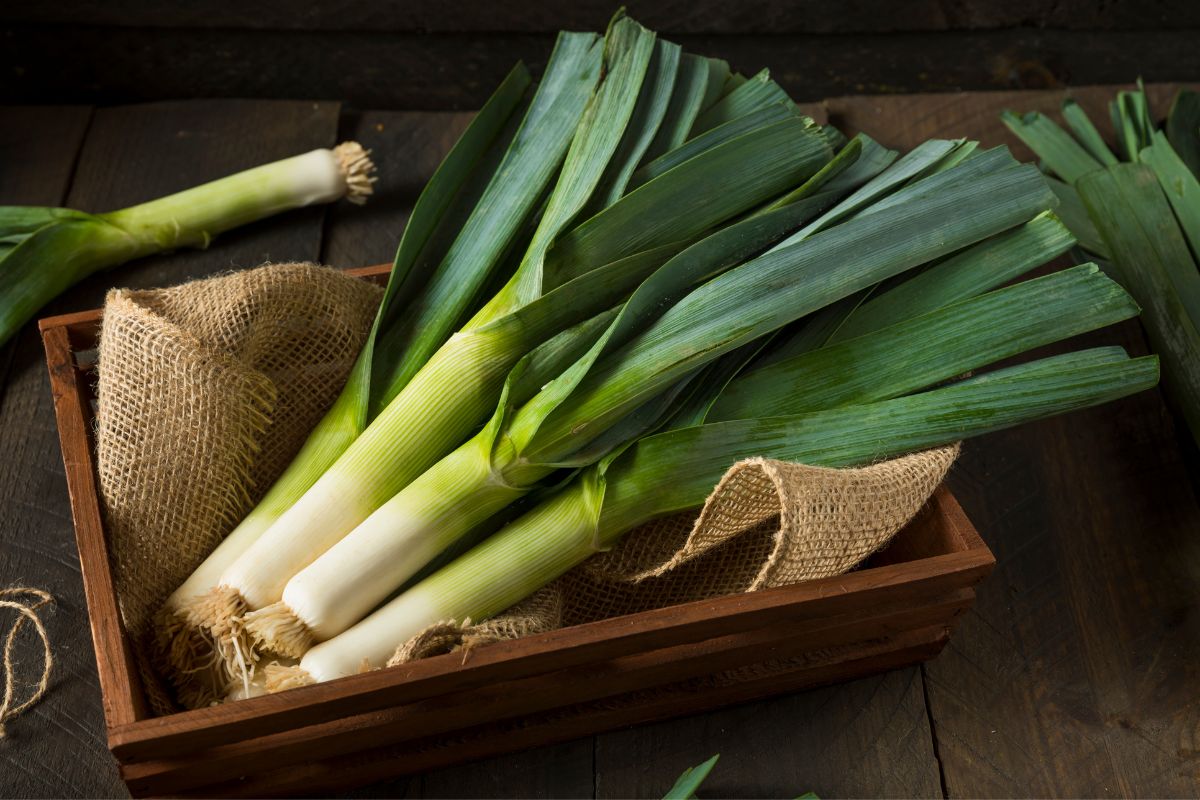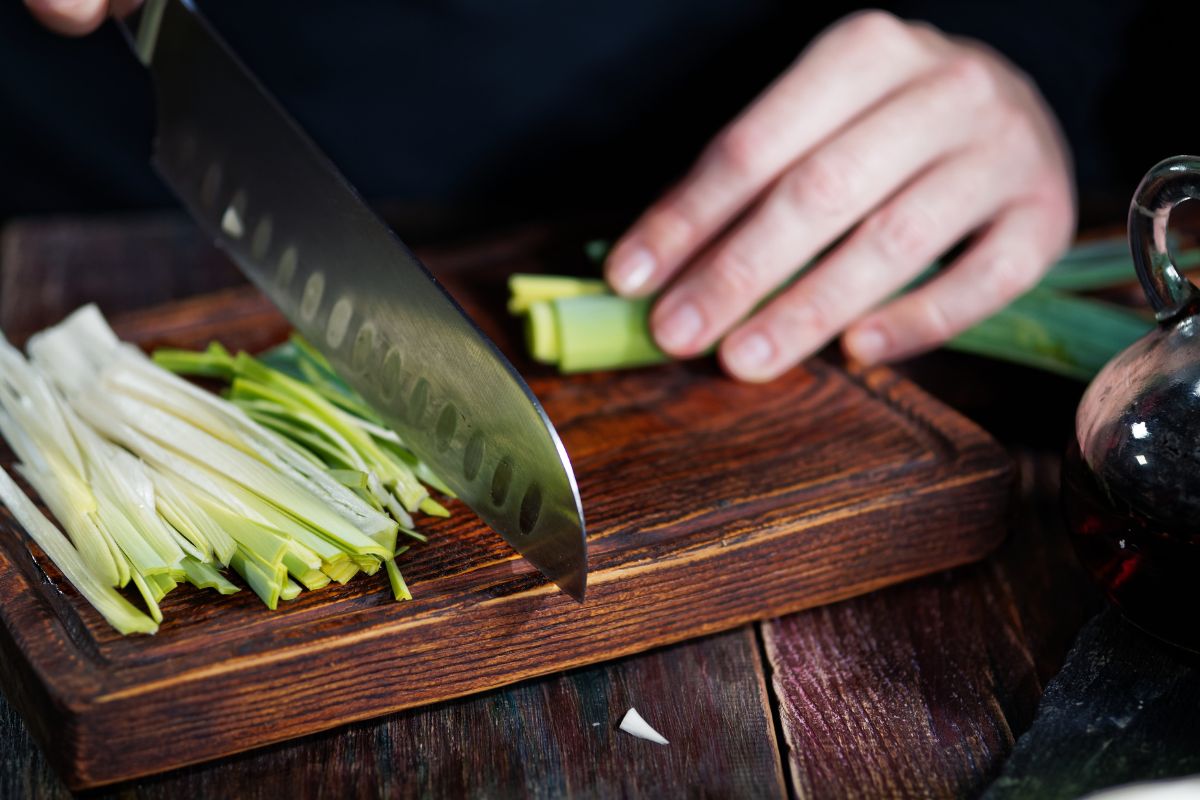Leeks are an interesting vegetable. We’ve all seen them before and most of us have probably used them in cooking but apart from that, what else do we know? The fact you’ve stumbled upon this post would tell us you know very little.

If that’s the case, you’re in the perfect place! In today’s post, we’re going to answer the question; what are leeks? We’re going to take a closer look at this unique vegetable, telling you exactly what it is, what it tastes like, how to prepare it, and its nutritional value.
We’ll even show you some of the best recipes you can make that include leeks as one of the main ingredients. If you want to learn more about leeks or simply want a delicious recipe to make, keep reading!
So, What Is A Leek?
We’ll kick things off by telling you what a leek is. Leeks belong to the onion family along with shallots, chives, garlic, and onions. This family is called the Allium family.
Like onions and other members of this family, leeks are a bulbous vegetable. They have white flesh and a leafy green top. However, unlike onions, leeks aren’t round. Instead, they are just slightly larger than the stem near the roots.
The edible part of a leek is made up of a cylindrical bundle of leaves. Because of its unique appearance, most people refer to this bundle as the stem or stalk.
The origins of the leek can be traced back to central Asia. This vegetable was commonly eaten by Greeks, Romans, and Egyptians.
What Does Leek Taste Like?
When it comes to taste, leeks don’t usually have a unique flavor. They taste quite similar to other members of the Allium family. Having said that, they do have a milder and slightly sweeter flavor than onions.
It’s also worth noting that leeks vary in flavor depending on how they are prepared. Raw leeks tend to have a more tender taste, while cooked leeks have a more mild and creamy flavor.
It isn’t unusual for leeks to have a somewhat grassy and herby taste too. This is why so many people add it to their dishes.
Which Parts Of The Leek Can We Eat?
While it might be tempting to eat the bulbous-looking part of a leek, this part isn’t edible. You should discard the root end and eat the rest of the leek instead.
You’ll want to eat the parts of the leek that are white and light green. These parts are easy to identify because they have a stem-like appearance.
You can eat the dark green leaves too but you should use them sparingly. The leaves can be quite bitter so you run the risk of ruining your dish with too much.
Nutrition
As far as nutrition goes, leeks are very healthy. Like their oniony brothers and sisters, leeks have a nutritional profile that’s packed with essential vitamins and minerals.
They are an excellent source of folate, vitamin A, and vitamin C. Leeks with dark leaves also contain a high source of vitamin K. When it comes to calories, 100 grams of leek contains approximately 60 calories.
Compared to other members of the Allium family, leeks typically boast more vitamins and minerals so they are a healthier option.

How To Cut Leeks
Preparing leeks isn’t too difficult. All we have to do is cut the leeks and wash them. While you would usually wash a vegetable before cutting it, you should always cut a leek first.
The reason for this is quite simple, leeks have multiple layers that trap lots of dirt. Cutting the leek first ensures we can clean away all the dirt first.
We’ve outlined the steps you need to follow to cut leeks below!
- Start by cutting the dark leaves off. These can be used another time or tossed away as they are quite bitter.
- Next, cut the roots found at the base of the vegetable. You’ll now be left with the edible part of the leek.
- You can cut the edible parts of the vegetable in many different ways. You can cut them into rings, half lengthwise, or in half-moons.
- Using a sharp knife, decide how you want to cut the leeks and do it.
- We recommend cutting your leek into 1-inch pieces.
How To Clean Leeks
After cutting your leek, you can start to clean it. Cleaning leeks can be quite tricky because they are experts when it comes to collecting dirt. However, now you’ve cut it into smaller pieces things become a lot easier.
To clean your leeks, place them in a colander and rinse them under cold water. They can then be left to dry before cooking.
Cooking With Leeks
Leek is a versatile vegetable that we can cook in many different ways. We can braise, roast, boil, and fry leek with ease. It can also be sauteed in butter or olive oil like onions.
The goal is to cook leeks until they have a tender texture. You should be able to put a fork through it with little effort. The recipes we’ve listed below are a perfect example of what we can do in the kitchen using leek.
Be sure to give one of the recipes a try!
1. Potato Leek Soup
Leek is commonly used to make soup. This creamy, crunchy, and fragrant potato leek soup recipe is to die for. You can make it in just over one hour.
2. Buttered Leeks
A great side dish you can make using leeks is buttered leeks. Ready to eat in 40 minutes, and calling for just 3 simple ingredients, this recipe is sweet, tender, and buttery.
What’s not to like?
3. Parmesan & Leek Quiche
This parmesan & leek quiche puts a unique spin on a classic French dish. The combination of rich and creamy cheese goes beautifully with the sweet and tender leek.
Final Thoughts
In this post, we’ve told you everything you need to know about leeks. We’ve told you what they are, what they taste like, how to prepare them, and so much more. You should now be a leek expert.
Now you know so much more about leeks, why don’t you head to your local grocery store and buy some? You could then try one of the delicious recipes from this post.
Frequently Asked Questions
No, leeks aren’t just big green onions. While they may look like big green onions, they are actually a completely different vegetable. They do belong to the same family though.
Sliced shallots are a great substitute for leeks. They have a slightly sweet and delicate flavor that isn’t too dissimilar in terms of taste.
- How To Reheat A Cheesesteak - November 5, 2023
- What Are Three Must Have Kitchen Knives? - September 22, 2023
- How To Protect Edges Of Pie Crust - June 15, 2023








